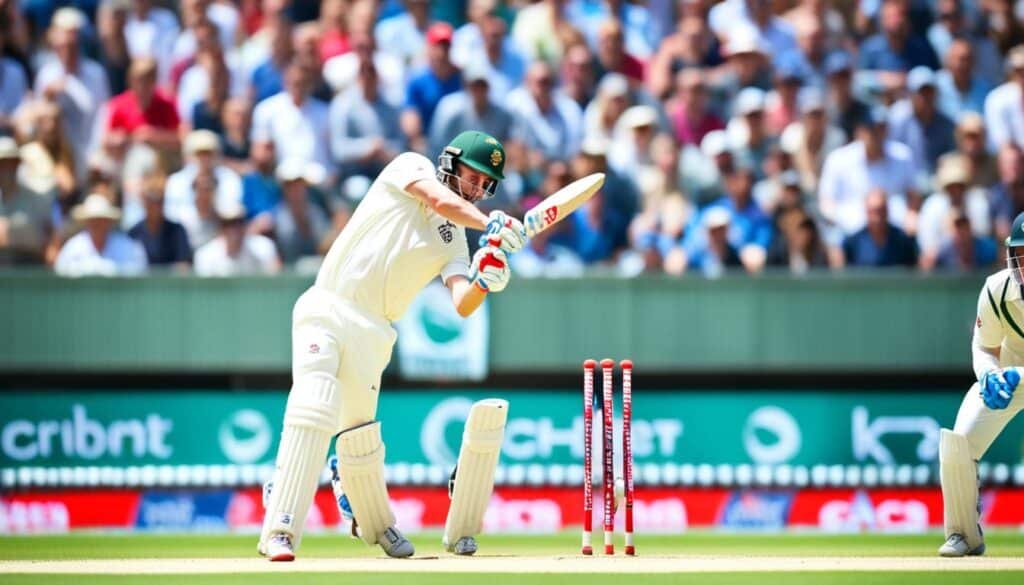Cricket How to Score:- Scoring in cricket is an essential skill that every player should master. Whether you are part of the batting team or the fielding team, understanding the scoring system and knowing how to score runs is crucial for success. In this article, we will provide you with valuable tips that can help you improve your scoring abilities and contribute to your team’s score.
Key Takeaways:
- Understanding the scoring system in cricket is crucial for success.
- Having a solid foundation in your batting technique is essential for scoring runs consistently.
- Utilizing the gaps in the field can increase your chances of scoring runs.
- Looking for quick singles even in defensive shots can help you accumulate runs.
- Having the intent to score and aiming for 1s and 2s can keep the scoreboard ticking.
Basic Batting Technique: The Foundation for Scoring Runs
https://www.youtube.com/watch?v=vjpQ2idpw84
Before focusing on Cricket How to Score scoring runs, it’s crucial to have a solid foundation in your batting technique. The ECB Coaches Association suggests ensuring your technique is sound and practicing tactical drills that simulate match conditions. By having a strong foundation, you’ll be better equipped to score runs consistently.
In cricket, the basic batting technique forms the cornerstone of a player’s ability to score runs. Whether you’re a seasoned pro or a beginner, having the right technique is essential to succeed at the crease.
One key aspect of the basic batting technique is the position of the feet at the crease. The batting crease is a line that marks the area where the batsman stands, and it is crucial to position your feet correctly behind this line.
Proper footwork is vital to maintain balance and enable precise shot-making. Your feet should be shoulder-width apart, with your weight evenly distributed between them. This stance provides a solid foundation for executing various strokes and allows for quick and decisive movements.
Additionally, maintaining a good grip on the bat and the correct hand position is crucial for a solid batting technique. Holding the bat too tightly can restrict your flexibility and shot-making ability. It’s essential to find a grip that feels comfortable and allows for maximum control.
Keep your top hand relaxed and your bottom hand firm on the handle. This grip provides stability and control while allowing for flexibility and maneuverability in shot selection.
Furthermore, the alignment of the body plays Cricket How to Score a crucial role in the basic batting technique. Your head and eyes should be level, allowing you to watch the ball closely as it leaves the bowler’s hand. The front shoulder should be pointing towards the direction of the bowler, ensuring you are properly positioned to play shots on both sides of the wicket.
By aligning your body correctly, you can improve your judgment of the ball’s line and length, enhancing your ability to score runs.
Practicing and refining your technique is essential to mastering the art of batting. The ECB Coaches Association recommends incorporating tactical drills into your training sessions to simulate match conditions and improve your decision-making skills.
One such drill is the “Throwdown Drill,” where a coach or teammate simulates the bowler’s action by throwing the ball from a short distance. This drill allows you to work on your footwork, timing, and shot selection under realistic conditions.
Another useful drill is the “Sidearm Drill,” where a coach or teammate uses a sidearm delivery action to replicate the pace and trajectory of a bowler. This drill helps you practice batting against faster bowling and develop quick reflexes.
By investing time and effort into mastering the basic batting technique, you will lay the foundation for scoring runs consistently and contributing to your team’s success.
Scoring from Gaps: A Positive Batting Tactic
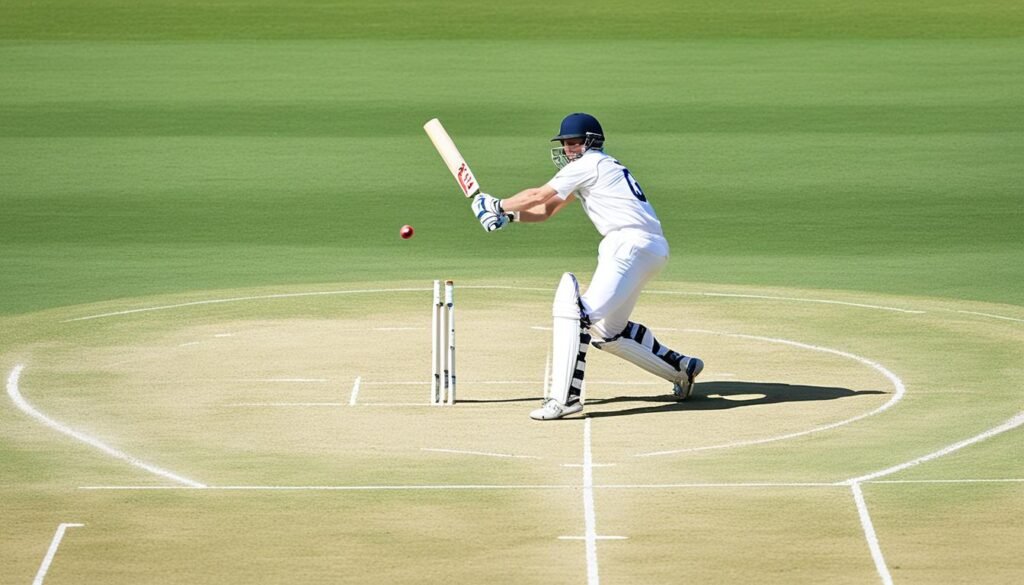
When it comes to scoring runs in cricket, one effective tactic is utilizing the gaps in the field. Instead of solely focusing on the fielders, pay close attention to the spaces between them. By identifying and targeting these gaps strategically, you can significantly increase your chances of scoring runs.
One example of utilizing the gaps is hitting the ball over the head of midwicket. This is a high-scoring area where fielders are often stationed deeper, creating a space to exploit. By timing your shot well and aiming to clear midwicket, you can find the boundary and add valuable runs to your score.
Another option is pushing the ball towards deep mid on. This area is typically left vacant by the fielding team, making it an attractive target for singles and quick runs. By nudging the ball into this gap and scampering between the wickets, you can accumulate runs consistently and keep the scoreboard ticking.
Remember, assessing the field and identifying gaps requires a keen eye and quick decision-making. By adopting a positive mindset and proactively searching for these scoring opportunities, you can manipulate the field and maximize your run-scoring potential.
Stay tuned for the next section, where we discuss the importance of quick singles in scoring runs even off defensive shots.
The Importance of Quick Singles: Scoring Even in Defensive Shots
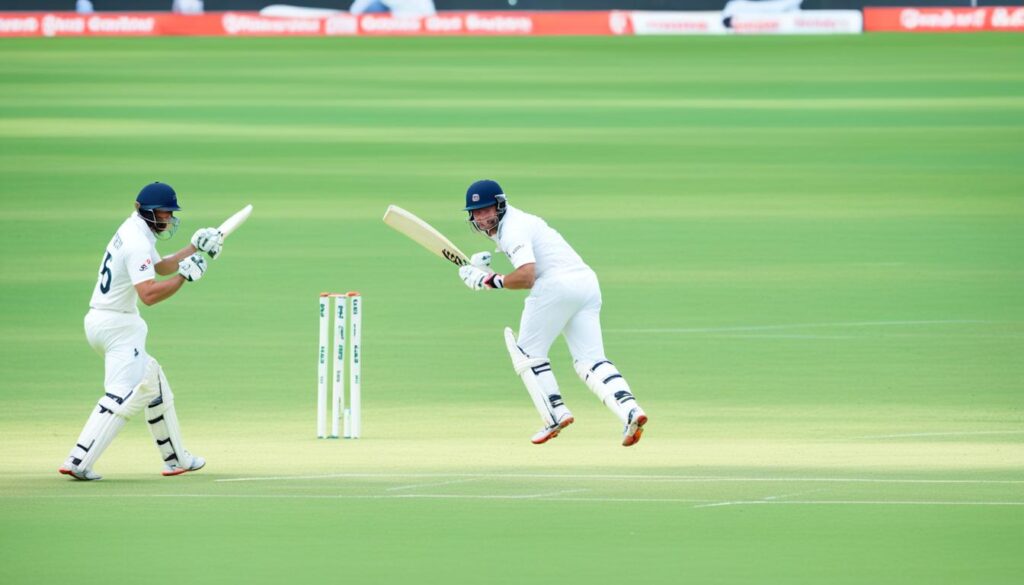
Scoring runs is not solely reliant on playing aggressive shots. Even when executing defensive shots, it is crucial to keep the idea of a quick single in mind. By being proactive and constantly looking for scoring opportunities, you can increase your run tally.
When playing a defensive shot, it is common to find gaps close to the batsman. These gaps provide an opportunity to steal a quick single and add runs to the scoreboard. By being aware of the positioning of the fielders and quickly assessing the gap that opens up, the batsman can exploit it and steal a run before the fielders can react.
“Scoring singles is about being smart and capitalizing on every scoring chance, even in defensive situations. When playing a defensive shot, it’s essential to stay focused and quickly close the gap between the batsman and the fielders.”
Close observation and a quick decision-making process are key in capitalizing on these opportunities. The batsman must react swiftly to the ball and immediately assess the possibility of a quick single, ensuring minimal risk of run-outs. By developing this mindset and actively looking for scoring opportunities, the batting team can accumulate runs more effectively.
Benefits of Quick Singles in Defensive Shots
Opting for quick singles in defensive shots offers several advantages:
- Keeps the strike rotating even in defensive phases
- Puts pressure on the fielding team by constantly challenging their agility
- Creates a rhythm and momentum that benefits the batting team
- Disrupts the fielding team’s plans by forcing them to adjust their field placements
Improving Quick Single Conversion Rate
To maximize the success of converting quick singles from defensive shots, the batsman needs to:
- Remain alert and mentally prepared to seize scoring opportunities
- Develop impeccable communication and understanding with the non-striking batsman
- Have a quick first step and accelerate between the wickets with swift footwork
- Practice judgment and make quick decisions based on field placements and the speed of the ball
| Batting Team | Fielding Team |
|---|---|
| 1 | 1 |
| 1 | |
| 1 |
Intent to Score: Accumulating 1s and 2s
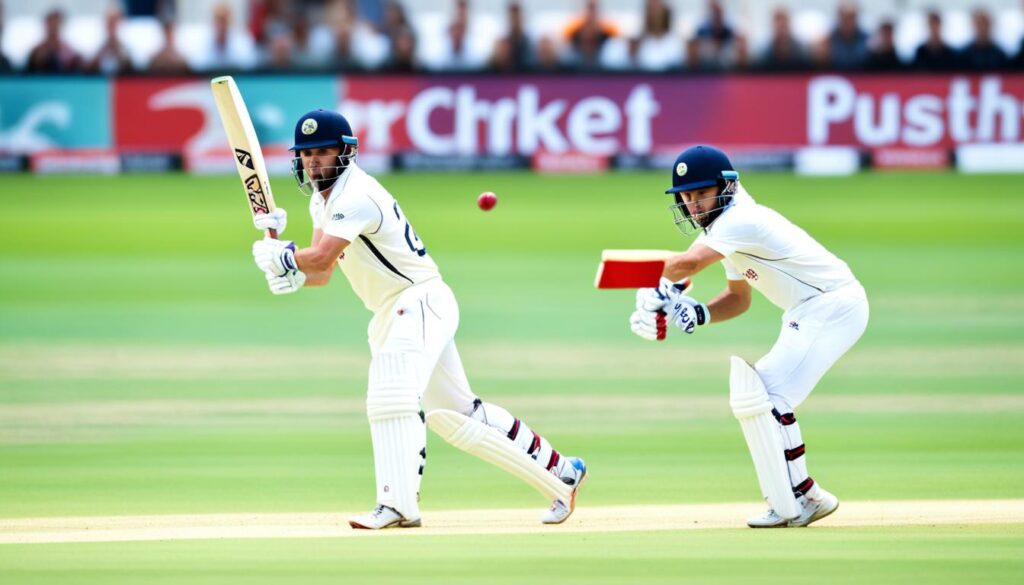
When it comes to scoring runs in cricket, having the intent to score off every ball is crucial. This approach is commonly adopted by successful ODI teams, enabling them to accumulate 1s and 2s consistently throughout the game. By maintaining a positive mindset and actively looking for scoring opportunities, you can keep the scoreboard ticking and build a solid run total.
Unlike playing the ball on merit alone, having the intent to score means actively seeking opportunities to rotate the strike and accumulate runs. It requires a proactive approach, constantly looking for gaps in the field and being ready to exploit them. Whether it’s pushing the ball into the gaps for quick singles or stealing a second run when the opportunity arises, intent to score allows you to maximize your scoring potential.
Adopting the intent to score mindset not only helps you build a solid run total but also puts pressure on the fielding team. By consistently rotating the strike, you create uncertainty and force the fielders to be on their toes. This can lead to misfields or wayward throws, providing additional scoring opportunities.
Successful ODI teams understand the importance of accumulating 1s and 2s. A game-changing boundary may come once in a while, but the consistent accumulation of singles and twos keeps the scoreboard ticking even when the boundaries are hard to come by. It ensures that the team maintains a healthy run rate, putting pressure on the opposition and building a solid total to defend or chase.
Key Benefits of Having the Intent to Score:
- Continuous run accumulation: By having the intent to score on every ball, you can keep the scoreboard ticking and accumulate runs consistently.
- Building pressure: The intent to score puts pressure on the fielding team, forcing them to be alert and make mistakes, providing more scoring opportunities.
- Stable run rate: Consistently accumulating 1s and 2s ensures a healthy run rate, even when boundaries are hard to come by, and sets the foundation for a competitive total.
- Team contribution: Having the intent to score allows every player in the batting lineup to contribute to the team’s total, rather than relying solely on big hitters to score boundaries.
By adopting the intent to score mindset, you can optimize your run-scoring potential and play a pivotal role in your team’s success. Remember, every ball provides an opportunity, and having the intent to score allows you to make the most of those opportunities.
Maximizing Your Hitting Zone: Key to Scoring Runs
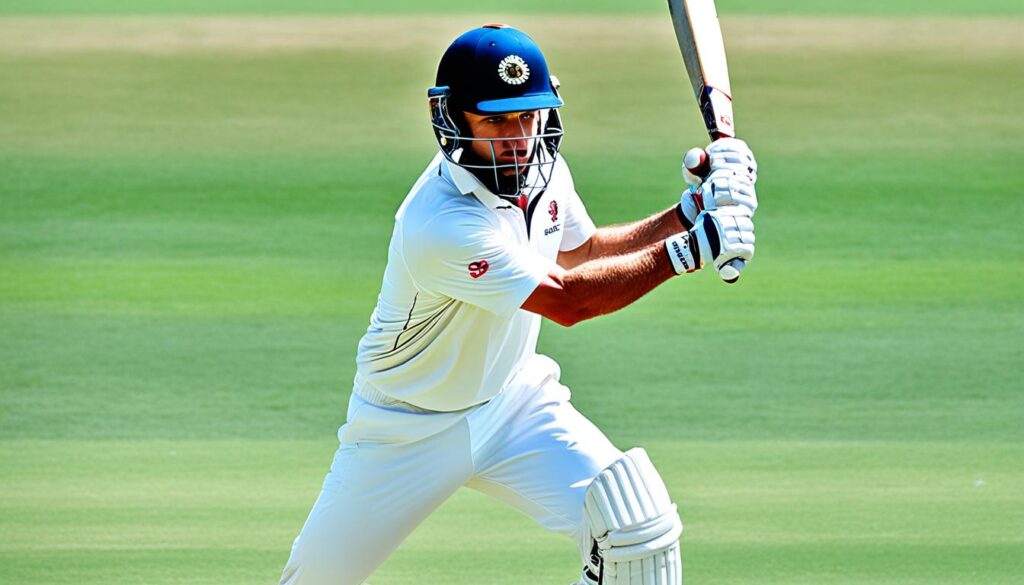
Scoring runs effectively in cricket requires the ability to maximize your hitting zone. By keeping your bat aligned with the ball for the maximum amount of time, you can play straight shots down the ground and increase your chances of scoring runs.
Good batting technique is essential for maximizing your hitting zone. It allows you to maintain control and accuracy while playing your shots. By practicing proper technique, you can improve your ability to hit through the line and make clean contact with the ball.
The Importance of Straight Shots
Playing straight shots is crucial for effective run-scoring. When you hit the ball straight down the ground, you minimize the risk of getting out and maximize your scoring opportunities. Straight shots are less likely to be intercepted by fielders and can result in boundaries or quick singles.
When you play straight shots, you also have a better chance of finding gaps in the field. By hitting the ball along the ground, you can exploit spaces between the fielders, giving yourself more chances to score runs.
“Playing straight shots down the ground is a key aspect of scoring runs in cricket. It allows you to control the ball and find gaps in the field.” – Michael Clarke
Scoring Runs with Straight Shots
| Straight Shot | Description | Scoring Potential |
|---|---|---|
| Straight Drive | A shot played with a straight bat towards the bowler | High potential for boundaries |
| Straight Push | A gentle shot played along the ground to find gaps | Opportunity for quick singles or twos |
| Straight Pull | A shot played towards the leg side along the ground | Potential for quick singles or boundaries |
By practicing and perfecting your straight shots, you can become a more effective scorer in cricket. Remember to maintain good technique, focus on hitting through the line, and exploit gaps in the field to maximize your scoring potential.
Adapting and Improvising: Building on the Basics
Once you have mastered the basics of batting technique, it’s time to take your skills to the next level by adapting and improvising in your shot selection. The best Twenty20 batters in international cricket excel at playing proper cricket shots while strategically hitting gaps in the field. This section will explore how you can leverage your technique to score runs strategically by focusing on hitting gaps and adopting finishing positions that maximize your scoring potential.
Playing proper cricket shots is essential when adapting and improvising. These shots include classic strokes like drives, cuts, pulls, and sweeps, which allow you to control the ball’s direction and placement. By maintaining good technique and executing these shots with precision, you can exploit the gaps in the field and find areas where the fielding team is less protected.
Another key aspect of adapting and improvising is playing with exaggerated finishing positions. This technique involves following through with your shot by closing the face of the bat and finishing in a strong, stable position. By doing so, you can manipulate the ball’s trajectory and direction, ensuring it reaches the gaps you aim for.
One way to practice adapting and improvising is by simulating game scenarios during net sessions. Set up fielders in different positions and challenge yourself to hit the ball through the gaps. This will help you develop your decision-making skills and improve your ability to adapt to different field settings.
Remember, adapting and improvising is about using your technical skills to make strategic decisions in real-time. It’s about finding innovative ways to score runs while still playing within the framework of proper cricket shots. By leveraging your technique, hitting gaps, and adopting finishing positions that optimize your scoring potential, you can become a highly effective batsman who consistently contributes to your team’s success.
Clearing the Front Leg: Safe Improvisation
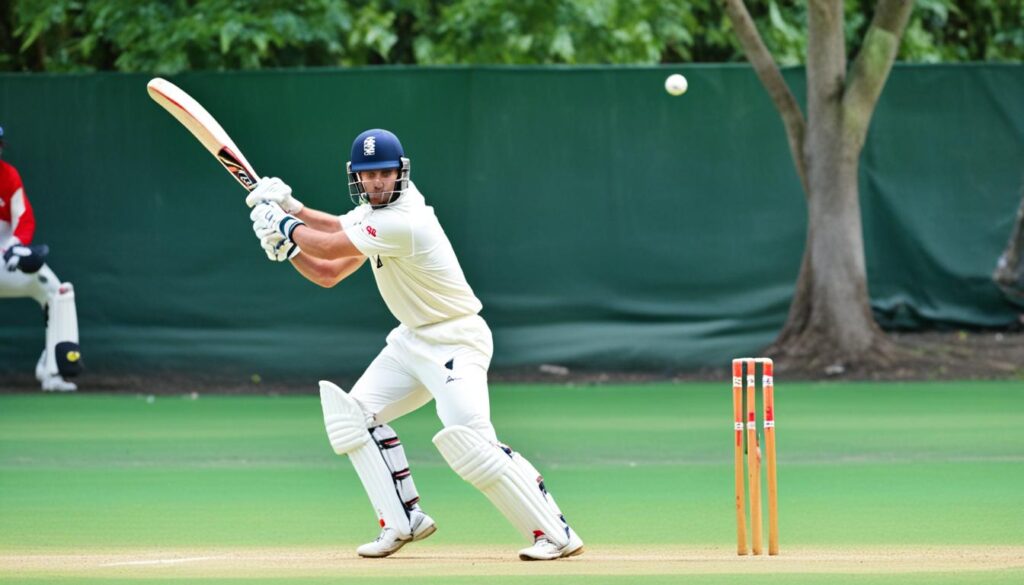
Clearing the front leg is a vital technique in cricket that allows you to score runs quickly and hit boundaries with reduced risk. By stepping back and across towards the off stump, you create a larger hitting zone, providing you with more options to play powerful shots such as hooks, cuts, and pulls. This technique not only enables you to generate more power but also allows you to swing the bat in a straight line, increasing your chances of scoring runs effectively.
Advantages of Clearing the Front Leg
- Expands the hitting zone, creating more opportunities for scoring
- Provides a wider range of shot options, such as hooks, cuts, and pulls
- Increases power and distance in shots, enabling boundaries
Clearing the front leg is particularly useful when facing fast bowlers or when you need to accelerate the scoring rate. It allows you to target specific areas of the field and create gaps where you can hit the ball with precision. However, it’s important to maintain balance and a solid base while executing this technique, ensuring you have complete control over your shots.
“Clearing the front leg not only gives you the freedom to score runs quickly but also puts pressure on the opposition by hitting boundaries. It’s about calculated risk-taking and capitalizing on the opportunity.” – Brendon McCullum, former New Zealand cricketer
When clearing the front leg, focus on aligning your body and keeping your head still. This will help maintain stability and enable you to generate maximum power from your shots. Practice this technique extensively in the nets to build confidence and ensure precise execution in match situations.
It’s important to note that clearing the front leg is best suited for certain situations and shot selections. Understanding the match context, the field placements, and the bowling strategy will help you determine when to utilize this technique effectively.
By mastering the art of clearing the front leg, you can confidently swing the bat and hit boundaries, putting pressure on the opposition and adding valuable runs to your team’s total.
Technique Adjustments for Moving Balls
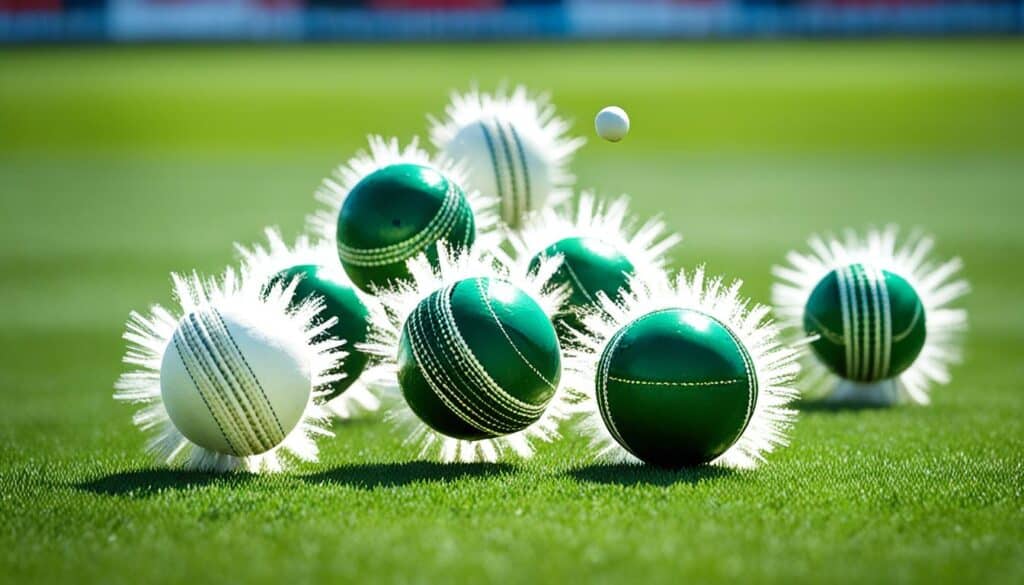
When facing moving balls, it’s important to make specific adjustments in your technique. Understanding the direction of the ball and stepping inside or outside the line can greatly improve your scoring opportunities.
“When the ball is moving away on the leg side, step inside the line and aim to hit on the leg side. This adjustment allows you to reach the ball more effectively and target scoring areas on the leg side,” explains Coach Mike Johnson, former international cricketer.
By stepping inside the line, you create a longer hitting zone and increase your chances of making contact with the ball. This adjustment also helps you to counter the swing or movement of the ball, allowing you to play shots with greater control and precision.
On the other hand, when the ball is moving away on the off side, it’s important to back away slightly and hit on the off side. This adjustment helps you to create space and prevent getting too close to the ball, which can result in mistimed shots or edges.
“Backing away slightly from the ball gives you the room to play shots on the off side with better balance and power,” advises Coach Johnson. “It’s crucial to judge the movement of the ball accurately and make the necessary adjustment to position yourself for a successful shot.”
Remember that technique adjustments for moving balls require practice and adaptability. By honing your skills and mastering these adjustments, you can effectively respond to the movement of the ball and maintain a long hitting zone, ultimately scoring runs with greater consistency.
Summary:
- Step inside the line when the ball is moving away on the leg side to hit on the leg side.
- Back away slightly when the ball is moving away on the off side to hit on the off side.
- These technique adjustments allow for a longer hitting zone and better control.
- Practice and adaptability are key to successfully scoring runs against moving balls.
Scoring Strategy: Calculated Risks and Shot Selection

When it comes to scoring runs in cricket, having a well-planned strategy and making wise shot selections are crucial. It’s important to balance aggression with caution and prioritize shots that have a higher chance of scoring boundaries, while minimizing the risk of getting out.
High-risk shots should be played in moderation and primarily used as a last resort to hit boundaries. Shots like left-handed hitting and reverse sweeps can be effective but should be approached with caution. These shots require a higher level of skill and precision, and if not executed properly, they can result in wickets and halt the scoring momentum.
Instead, focus on shots that have a better chance of scoring boundaries consistently. This could include shots like straight drives, cover drives, and cuts, which allow you to take advantage of gaps in the field and find the boundary line. By choosing these shots wisely, you can maintain control over your innings and keep the scoreboard ticking.
Shot selection should be based on the pitch conditions, the fielding placements, and the bowler’s strengths. Analyzing these factors will help you determine which shots are more likely to yield positive results. Additionally, it’s important to adapt your shot selection based on the match situation and the required run rate. In high-pressure situations, playing safer shots and focusing on rotating the strike can be equally effective in accumulating runs and building partnerships.
Remember, scoring runs is not just about hitting boundaries. It’s about finding the right balance between aggression and caution, understanding the game situation, and making calculated shot selections. By adopting a strategic approach to shot selection, you can maximize your scoring opportunities and contribute significantly to your team’s total.
Key Points:
- Have a calculated strategy when it comes to shot selection
- Use high-risk shots like left-handed hitting and reverse sweeps sparingly
- Prioritize shots with a higher chance of scoring boundaries
- Consider pitch conditions, fielding placements, and bowler’s strengths
- Adapt shot selection based on the match situation and required run rate
- Focus on finding the right balance between aggression and caution
Also read:- The Indian Women’s Cricket Team Will Play Home Tests Against Australia And England In 2023-24.
Conclusion
Scoring runs in cricket is vital for both team success and individual performance. By incorporating the tips and strategies mentioned in this article, you can improve your ability to score runs and make valuable contributions to your team’s score. The key is to focus on honing your technique, adapt to different scenarios, and make calculated shot selections to maximize your run tally.
Remember, consistent practice and dedication are crucial to becoming a proficient scorer in the game of cricket. By following these guidelines, you can enhance your run-scoring abilities and make a significant impact in the sport.
So, whether you’re a budding cricketer eager to improve or an experienced player looking for ways to take your scoring to the next level, these strategies will help you on your journey. Keep refining your skills and being mindful of the specific techniques and tactics required to score runs effectively. With perseverance and determination, you’ll become a valuable asset to your team and achieve success in the game.
FAQ
Q: What is the objective of cricket?
A: The objective of cricket is to score more runs than the opposing team within a specified number of overs.
Q: How are runs scored in cricket?
A: Runs in cricket are scored by the batting team when the batsmen run between the wickets, or when the ball is hit to the boundary, resulting in 4 or 6 runs.
Q: What are penalty runs in cricket?
A: Penalty runs in cricket are awarded to the opposing team for various infractions, such as tampering with the ball or fielding infractions.
Q: What is a wicket in cricket?
A: In cricket, a wicket refers to the event when a batsman is dismissed, either by being bowled, caught, lbw, run out, or stumped by the fielding team.
Q: How do you keep score in cricket?
A: The scoring work in cricket involves recording the number of runs scored, number of wickets taken, and number of overs bowled by the bowling team.
Q: What are extra runs in cricket?
A: Extra runs in cricket are runs that are added to the batting team’s score due to fielding errors, such as no-balls, wides, and penalty runs.
Q: What are overs in cricket?
A: Overs in cricket refer to a set of six legal deliveries bowled by a bowler from one end of the pitch to the batsman at the other end.
